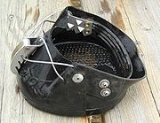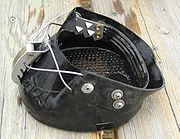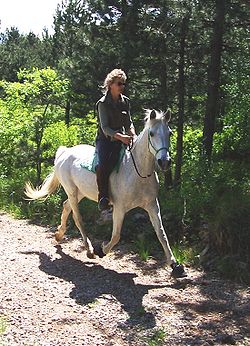
Hoof boot
Encyclopedia

Horse hoof
A horse hoof is a structure surrounding the distal phalanx of the 3rd digit of each of the four limbs of Equus species, which is covered by complex soft tissue and keratinised structures...
of a horse
Horse
The horse is one of two extant subspecies of Equus ferus, or the wild horse. It is a single-hooved mammal belonging to the taxonomic family Equidae. The horse has evolved over the past 45 to 55 million years from a small multi-toed creature into the large, single-toed animal of today...
as an alternative to, and occasionally in addition to, horseshoe
Horseshoe
A horseshoe, is a fabricated product, normally made of metal, although sometimes made partially or wholly of modern synthetic materials, designed to protect a horse's hoof from wear and tear. Shoes are attached on the palmar surface of the hooves, usually nailed through the insensitive hoof wall...
s. It is often used as a protective device when the animal has a hoof injury that requires protection of the sole of the hoof, or to aid in the application of medication. There are many different designs, but all have the goal of protecting the hoof wall and sole of the horse's hoof from hard surfaces, rocks and other difficult terrain.
Hoof boots are most commonly seen as a substitute for horseshoes, either as a backup for a thrown shoe when a farrier
Farrier
A farrier is a specialist in equine hoof care, including the trimming and balancing of horses' hooves and the placing of shoes on their hooves...
is not available, or as a temporary form of additional protection to a barefoot horse
Natural hoof care
Natural hoof care is the practice of keeping horses so that their hooves are worn down naturally and so do not suffer overgrowth, splitting and other disorders...
that may be subjected to conditions that its unshod hooves are not able to handle without damage. Horse boots are particularly popular for trail riding
Trail riding
Trail riding sometimes called horse or pony trekking is riding outdoors on natural trails and roads as opposed to riding in an enclosed area such as a riding arena. The term may encompass those who travel on horses, on mountain bikes, or on motorcycles and other motorized all-terrain vehicles...
and endurance riding
Endurance riding
Endurance riding is an equestrian sport based on controlled long-distance races. It is one of the international competitions recognized by the FEI. There are endurance rides worldwide....
, though are also sometimes seen on horses in parades and on police horses who have to work on hard pavement. They may also be used when transitioning a horse from shod to unshod riding, or carried during a ride in case a horse throws a shoe.

Veterinary medicine
Veterinary Medicine is the branch of science that deals with the prevention, diagnosis and treatment of disease, disorder and injury in non-human animals...
. If a horse has a puncture wound in the hoof or a bruise to the sole, the boot provides protection to the wound or injury, increases the cleanliness of the area, and may at times be used to keep a poultice
Poultice
A poultice, also called cataplasm, is a soft moist mass, often heated and medicated, that is spread on cloth over the skin to treat an aching, inflamed, or painful part of the body. It can be used on wounds such as cuts...
or other medication in contact with the hoof. They are also very useful for protection of the hooves of horses who cannot for some reason wear horseshoes, such as a horse that has lost a large chunk of the hoof wall due to disease or injury. In some cases, horses with laminitis
Laminitis
Laminitis is a disease that affects the feet of ungulates. It is best known in horses and cattle. Symptoms include lameness, and increased temperature in the hooves...
also respond well to the protection of hoof boots while their hooves recover.
As a general rule, hoof boots are not kept on horses full time, rather they are put on and taken off as needed. Riding horses have their boots removed daily at the end of the ride, though they may be kept on for a couple of days without harm if properly adjusted and watched carefully for rubs and slippage. In the case of horses with injuries, they may be kept on for longer periods of time, but need to be periodically removed, cleaned, and the horse checked for rubbing or unusual abrasions, after which the boot may be replaced.

